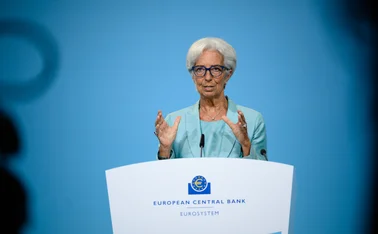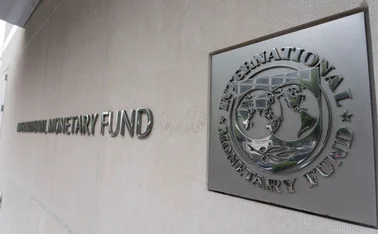
More reserve managers use ETFs

More central banks are using exchange-traded funds (ETFs) to diversify their reserves in pursuit of safety, liquidity and returns.
According to BlackRock’s Laurence Fink, chairman and chief executive, and Stanley Fischer, senior adviser, ETFs have proven more liquid in highly stressed market conditions than their underlying asset markets. The Bank of England (BoE) in its analysis found that, during the ‘dash for cash’ in 2020, ETFs could serve as a source of price discovery.
In the aftermath of the financial crisis that began in 2007–08, central banks began actively balancing volatility and liquidity constraints against income objectives, Fink and Fischer said. “Many central banks believe reserve assets that are well diversified across currencies and asset classes generate better risk/return outcomes without compromising their liquidity needs.”
The low cost of adopting EFTs, often in single-digit basis points, is a way of gaining exposure to a wide range of indexes. This, coupled with simple and transparent execution, has further increased their popularity among central banks.
Henry Jim, an ETF analyst at Bloomberg based in Geneva, says central banks are also increasingly using ETFs to inject liquidity into their markets compared with buying government bonds at auction or buying individual stocks. Strategically, they can use ETFs to target specific industries or sectors in need of support.
Whether ETFs products can preserve capital (safety) or add value to reserve portfolios (return) for central banks also remains debatable.
Antonio Sánchez Serrano, senior lead financial stability expert at the European Systemic Risk Board (ESRB) Secretariat, says ETFs are not products to preserve initial investment.
“This means that, ultimately, investors can come out with less money than they invested,” Serrano says.
“If the goal is capital preservation, then the appropriate research and diligence should be undertaken by the investors,” Jim says. ETFs, if intended for capital preservation purposes, are highly dependent on the underlying asset, rather than the ETF wrapper.
“There are asset classes that have been traditionally used and available in ETFs, such as precious metals and government bonds,” Jim adds. “There are also some strategies with ‘defined’ outcomes that provide broad market performance returns with some downside protection.”
Jim also points out that central banks do not traditionally use ETFs, more so in reserves. The Bank of Japan (BoJ) was among the first central banks in the world to purchase ETFs, about a decade ago, to support equity prices amid a seizing up of Japan’s stock market at that time.
“Purchasing ETFs made sense for the BoJ as it aligned with its mandate of stabilising the market and also preventing further acceleration of deflation,” Jim says. In another high-profile and more recent example, the US Federal Reserve purchased over $8.7 billion worth of ETFs in 2020 – mostly fixed-income ETFs – as part of the continuation of its quantitative easing programme.
The range of ETF exposures held by reserve managers – rather than their monetary policy operations peers – is detailed in another section of this Central Banking ETFs in reserve management focus report. Underlying exposures include equities in developed and developing markets, emerging market debt and corporate bonds, as well as environmental, social and governance, and climate ETFs.
Central bank reserves managers, when considering whether to use ETFs, might also learn from other examples of trusted public bodies aligning their use of ETFs with their mandates.
In certain Latin American countries – specifically Chile, Columbia, Mexico and Peru – ETFs have been the vehicle of choice for their national pension funds.
“The [public pension funds in these four Latin American countries] have worked for many years with ETF issuers to understand and compare them with other investment vehicles, and decided that ETFs fit their mandates of investing for their workers because of low fees, transparency in holdings and liquidity,” Jim says.
ETFs have proven particularly popular in Latin America, compared with Europe and Asia, largely because emerging market economies have seen their nationally administered pension funds decimated after each financial crisis.
“As the idea spread to other countries, it coincided with the rise and acceptance of ETFs, which fit in well with pension fund mandates with their characteristics of low fees, liquidity and transparency,” Jim says.
While choosing the right exposures and vehicles can be complex, ETFs have also become a popular vehicle for transferring risk – particularly in times of extreme market volatility – according to Crystal Wan, financial markets advisory at BlackRock. This is evidenced from the sharp increases in ETF trading volumes during the global financial crisis and, more recently, the Covid‑19 pandemic.
Notwithstanding the popularity of ETFs, the Financial Stability Board warned in 2011 of the risks of synthetic ETFs. Though they represent a smaller share of the ETF ecosystem, the use of the umbrella term ‘ETF’ to refer to both simple ETF structures, such as those tracking the S&P 500, and more ‘complex’ products can misguide less informed investors. This can lead to large losses – particularly when markets are volatile, says the ESRB Secretariat’s Sánchez Serrano.
Sánchez Serrano tells Central Banking that the fundamental issues around ETFs and the risk they can potentially pose to investors is closely related to the type of replication chosen. “Simple ETFs with physical replication (for example, on the S&P 500) have a straight functioning, as they are expected to move exactly as the underlying index,” he says. “If the index declines, the value of the shares decline too.”
More complex structures associated with synthetic ETFs, which make intense use of derivatives to replicate the index, or other similar products (such as exchange-traded notes tracking the Vix) can be subject to high volatility and induce large losses to investors over short periods of time. For example, the volatility spike of February 2018 caused the collapse of inverse leveraged ETFs tracking the Vix, Sánchez Serrano says.
A 2019 report by the ESRB’s Advisory Scientific Committee identified four channels through which ETFs could increase systemic risk.
First, there is evidence to suggest that prices of the underlying financial assets tend to co-move with the respective index when they are included in the basket of ETFs. “This co-movement may be particularly concerning in times of market stress and/or if the underlying assets are relatively illiquid,” Sánchez Serrano says.
Second, ETFs allow investors to take large, correlated positions in financial markets, with the risk that they unwind those positions simultaneously during times of financial stress, leading to large movements in asset prices.
Third, during times of financial stress, the arbitrage mechanism behind ETFs may not work perfectly and ETF prices may decouple from the prices of the underlying assets. “That would occur if authorised participants are not able or willing to convert ETF shares as demanded by investors,” Sánchez Serrano says.
Fourth, where there is large concentration in the ETFs market, the materialisation of operational risk in one of the largest ETF providers may generate spillovers and fire sales.
There also remain uncertainties that may further exacerbate the risks posed by ETFs. One potential issue is the influence of the largest ETF providers on the strategic decisions of non-financial corporations.
Sánchez Serrano also notes that large swings in ETF prices may create systemic risk if certain investors hold large ETF positions on their balance sheets, or rely heavily on ETF shares in their liquidity management operations, particularly in times of market stress when liquidity in the financial markets is more valuable.
Jim of Bloomberg cautions that ETFs, like any other listed and publicly traded security, have risks and limitations in a volatile environment. These limitations include a lack of liquidity if market-makers pull back and a lack of pricing transparency, which can happen when markets seize up and the underlying assets are not trading.
He also reiterated that ETFs have shown themselves to be vehicles of price discovery in past financial crises and have served as release valves for otherwise frozen markets where there was a lack of bid and offer. “ETFs have provided confidence to the markets under those circumstances, if not outright stability in some instances,” he adds.
The BoE, in its analysis, however, also pointed out that, in future stress periods, if investors anticipate from ETF net asset values (NAVs) that open-ended fund NAVs are “stale”, this could “trigger a first-mover advantage”, and “contribute to the sort of market dysfunction seen in March 2020”.
This feature forms part of the Central Banking focus report, ETFs in reserve management 2022
Only users who have a paid subscription or are part of a corporate subscription are able to print or copy content.
To access these options, along with all other subscription benefits, please contact info@centralbanking.com or view our subscription options here: http://subscriptions.centralbanking.com/subscribe
You are currently unable to print this content. Please contact info@centralbanking.com to find out more.
You are currently unable to copy this content. Please contact info@centralbanking.com to find out more.
Copyright Infopro Digital Limited. All rights reserved.
You may share this content using our article tools. Printing this content is for the sole use of the Authorised User (named subscriber), as outlined in our terms and conditions - https://www.infopro-insight.com/terms-conditions/insight-subscriptions/
If you would like to purchase additional rights please email info@centralbanking.com
Copyright Infopro Digital Limited. All rights reserved.
You may share this content using our article tools. Copying this content is for the sole use of the Authorised User (named subscriber), as outlined in our terms and conditions - https://www.infopro-insight.com/terms-conditions/insight-subscriptions/
If you would like to purchase additional rights please email info@centralbanking.com
Most read
- ECB says iPhone is currently incompatible with digital euro
- Supervisors grapple with the smaller bank dilemma
- ‘Do I die, or do I survive?’ Officials reflect on Basel III complexity







